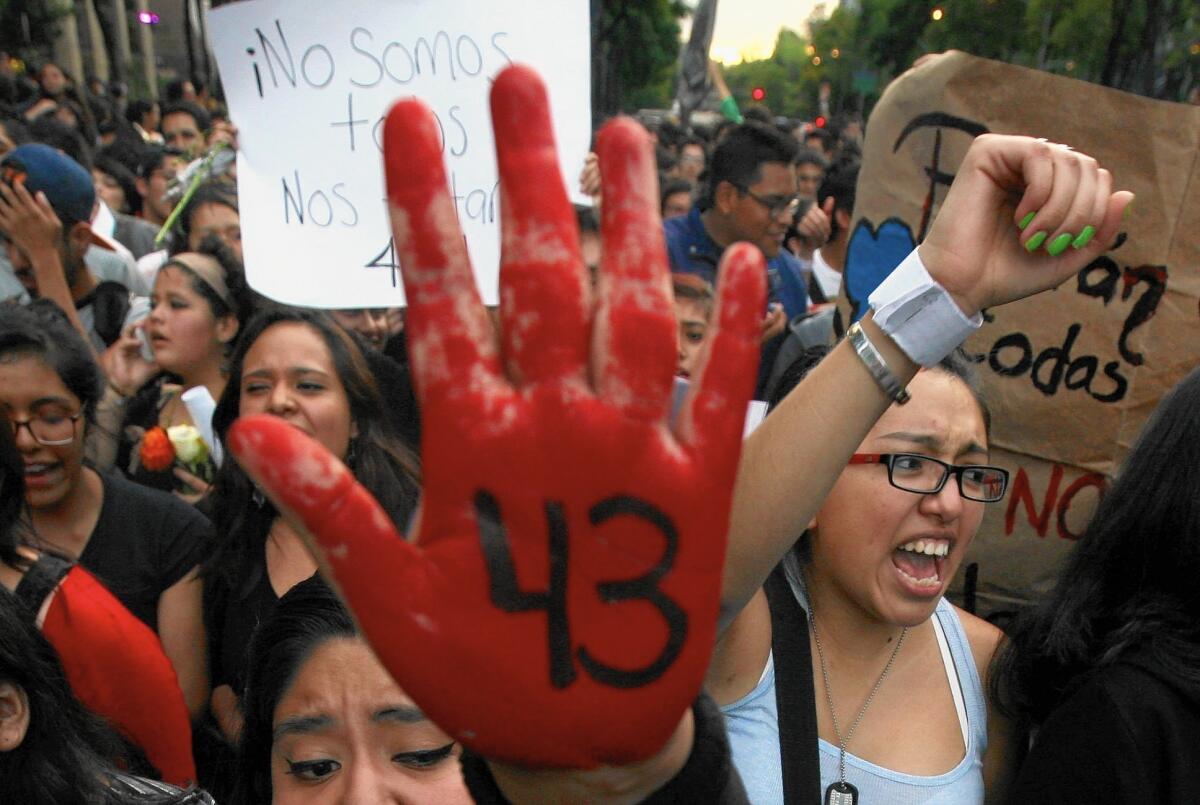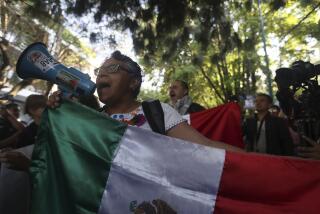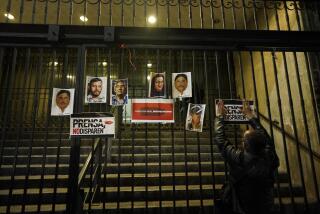Exit of Guerrero state governor seen as too little in Mexico

The government of President Enrique Peña Nieto is hoping that Thursday’s removal from office of the governor of Guerrero state will lower the explosive tension roiling the nation over the Sept. 26 disappearance of 43 college students.
But Gov. Angel Aguirre’s forced decision to step down is unlikely to satisfy tens of thousands of mostly young people and their parents, who have been taking to the streets across Mexico to protest.
Nor is it likely to quiet other critics taking Peña Nieto to task for what they consider a head-in-the-sand approach to an egregious breakdown of law and order in much of Mexico.
It was essential that Aguirre go, some said Friday, but his exit does not even begin to address the fundamental security crisis, which goes far beyond Iguala and Guerrero.
The missing students were last seen in the Guerrero city of Iguala after police attacked their group, killed six people, and led the survivors away. Federal authorities said the attack was ordered by Mayor Jose Luis Abarca and his wife, Maria de los Angeles Pineda, in collusion with corrupt police and local drug gangs.
In the days that followed, searchers found several hidden mass graves around Iguala and exhumed about 30 bodies. None have yet been linked to the students. News reports said an additional nine graves were discovered Friday that seemed to have been dug recently and contained backpacks and pencils.
“We will not be satisfied until [Aguirre] … is behind bars,” Uriel Alonso, a student leader from the same college attended by the missing, said Friday. In Guerrero, demonstrators surrounded the state congressional building and repeated a frequent tactic: torching government property.
On Wednesday night in Mexico City, thousands of people, many carrying candles, marched through the capital. At one point the crowd stretched from the iconic Angel of Independence statue to downtown’s Zocalo square, a distance of nearly three miles. The demonstration was generally peaceful.
The most common slogan of the protests has been the demand for the resignations of both Aguirre and Peña Nieto. Though the latter won’t happen, the sentiment underscores the belief that the Iguala case is only, as one political leader put it, the tip of the iceberg. It is quickly coming to symbolize Mexico’s serious security problems, long downplayed by Peña Nieto’s government as he sought to focus on opening up the Mexican economy and improving the country’s image abroad, while also concentrating security authority and policy in the central government, to the neglect of the states.
Since taking office nearly two years ago, Peña Nieto “wanted to lower the profile of violence and insecurity, and there were deliberate efforts to do so,” Edna Jaime, general director of Mexico Evalua, an organization that studies security and other public policy, said in an interview.
“The disappearances, the mass graves take us to the past brutal images,” she said. “We had had a parenthesis, but the problems were always there. It was a wound that had not been cured.”
Many in Mexico say the latest incidents remind them of one of the country’s darkest chapters, the so-called dirty war of the 1960s and ‘70s, a period of lawlessness and extreme repression of dissidents. And several analysts and politicians warned that increasingly violent protests could reawaken latent guerrilla movements — especially in Guerrero, long a hotbed of radical activity and thought.
“What worries us is a scenario … that provokes general social instability,” Sen. Luis Miguel Barbosa said Friday. He is from the same leftist Democratic Revolution Party, or PRD, as Aguirre. “I hope that radical groups don’t find in these moments of uncertainty an opportunity for their own” agendas.
Peña Nieto also addressed a rising tide of violence, saying he understood protesters’ demand for justice but that it cannot go hand in hand with vandalism.
His government is clearly concerned it is losing a finely crafted domestic and international public relations campaign that emphasized major reforms of Mexico’s energy sector.
Publications in the U.S. and Europe that once lavished praise on the president have turned the tables. Echoing the European Union and other international bodies, the United Nations’ Office of the High Commissioner for Human Rights on Friday urged the Mexican government to redouble its efforts to find the missing students. It also asked to be allowed to interview families of the missing.
Thousands of people have been reported missing, some taken away by security forces, others by drug gangs, in the eight years since Mexico launched a battle with drug trafficking cartels.
Peña Nieto erred, commentator and writer Jorge Zepeda Patterson said Friday. “It was thought that the economic changes would be the platform to transform [Mexico’s] reality — and maybe that would be true in a less surreal country,” Zepeda wrote in an op-ed piece in the Spanish newspaper El Pais.
“President Peña Nieto believed economic reform would be enough to leave behind the barbaric Mexico. Obviously, that’s not been the case.”
More to Read
Start your day right
Sign up for Essential California for news, features and recommendations from the L.A. Times and beyond in your inbox six days a week.
You may occasionally receive promotional content from the Los Angeles Times.







